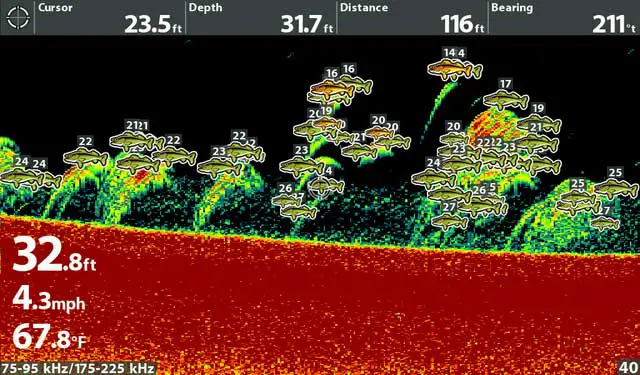To help you make the right decision on which fishfinder is among the best in the market, we have undergone an in-depth research and have come up with the 5 best side imaging scan fish finder to make your fishing hunt a breeze.
What is a side imaging fish finder?

Simply put, Side imaging fish finder is a sonar device designed to make your time on the water productive. It is an improved sonar technology that comes with a particular transducer, you’ll need to mount on the outside of the boat transoms.
This sonar technology offers advanced features to capture improved pictures of underwater structures and to help you locate more fish.
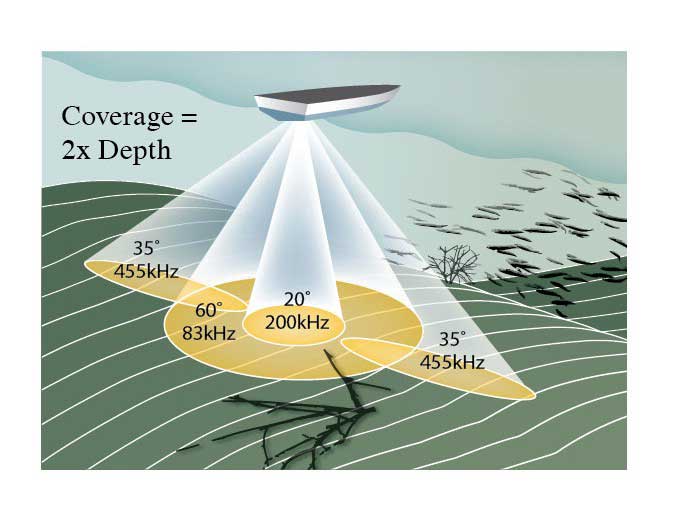
Side imaging fish finders use two sonar beams, which are located on both sides of the boat. The two sonar beams are positioned in a right angle direction of the path of the boat to cover about 300 feet of water roundabout.
The majority of SI sonar could be operated at two frequencies of 800 kHz and 455 kHz. And will look down beneath the side of the boat and projects up to 240 feet with 440 foot photo-like coverage across the water bottom.
Due to the potency of side imaging scan fish finders, they aren't affected by light, darkness or even mud and silt. With the best side imaging fish finders, natural structures, automobiles, submerged wreckage boats, and even schools of baitfish, will all show up in clear and clean detail.
In addition to this, you can run your side imaging in both fresh and salt water; in deep and shallow water that is as low as three feet.
What am I looking at with Side Imaging?
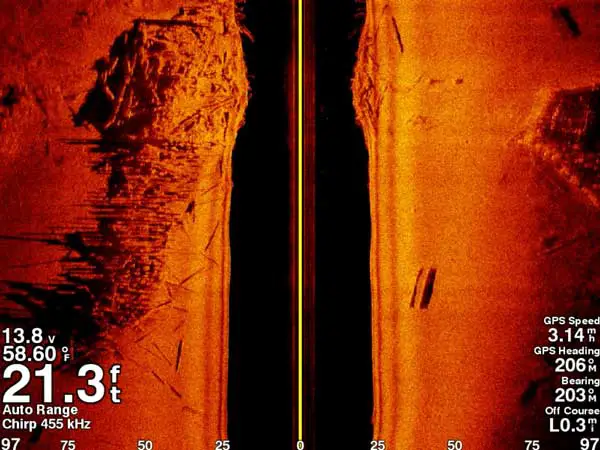
You are looking out for fish, which is the sole aim of buying the SI technology. The sonar technology essentially will point out a lot of fish from the bass of the river, which will appear as white dots or obscure shapes on the screen.
While you may see some as shadows, indicating these are more or less above the undermost part of the river, this in general, tells you that the farther the fish shadow is cast, the higher in the water queue is the fish.
For example, Baitfish will show up as cloud shapes. Drops and ditches will look like dark shapes or lines on the side imaging screen. Rocks, grass, trees or any structure at all can immediately be identified.
From your screen view, your boat will show in the center of the image. It will appear like a small arrow-like shape and create turbulence bright-white line. However, whatever fish or structure are exposed in these dark bands, they are generally viewed in the water column beneath the boat, or on the left or right side of the boat, different than down imaging.
Best Side Scan Fish Finder Reviews
1. Humminbird 410120-1 Helix 10 CHIRP Mega Si GPS G2N Fishing Charts & Maps

My bet is that you are going to catch more fish if you use the Hummingbird 410120-1. The reason is that the Helix 410120-1 is packed with a lot of high-end features to make your fish hunt a breeze.
The Helix 10 is a new generation of the ‘Core Series’. The core series replaces the 800 and 900 series. It packs a big screen as well as several incredible features, making it our top recommended side imaging fish finder.
It features GPS chartplotter alongside built-in Bluetooth, with vegetation and bottom hardness mapping, Ethernet networking capabilities, and unit cover.
Design
The design of the Humminbird 410120-1 is a huge improvement compared to previous generations. It sports a huge 10.1” display screen that lets you easily manipulate, and see the Mega Side Imaging and Mega down imaging and Chirp Sonar technology.The device is made in a plastic body which comes as a complete redesign from Humminbird. It has an edge to edge glass front that looks sleek with the display giving it a luxury feel.
The menus of the fish finder have been graphically updated even though they are really the same. Compared to older models, the keypads are firmer. The cursor now moves from one point to another quite smoothly.
MEGA Side and Down Imaging
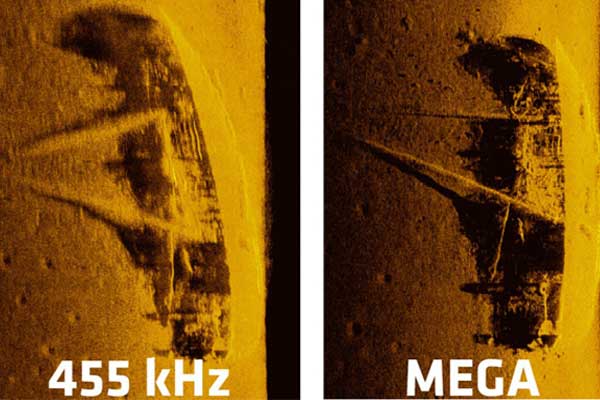
Mega Side imaging is an impressive feature that deserves massive praise. Unlike standard side imaging sonar, this unit will show you more detail and let you uncover 3x more output in the most precise detail.
You will get unparalleled underwater clarity coverage up to 125 feet on both sides of the boat.
CHIRP Digital Sonar
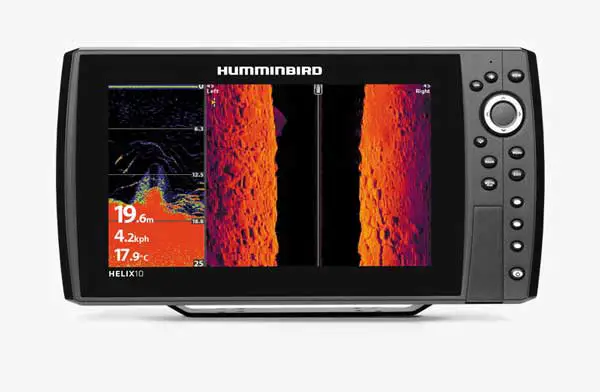
This absolute beast also moved a step by featuring a revolutionary chirp sonar to give you a crystal clear view of individual fish, reach more depths and range, and identify baits and structures.
Dual Beam PLUS Sonar
To give the most fishing experience, hummingbird decided to sport Dual Beams for more detail and broader coverage to let you identify fish, contours, and structures - Thanks to its ability to use both the 200 kHz and 83 kHz channels to observe returns in split-screen.With this added feature, you will be able to get accurate information on fish, have the true nature of bottom profile and exact details on structure and bottoms.
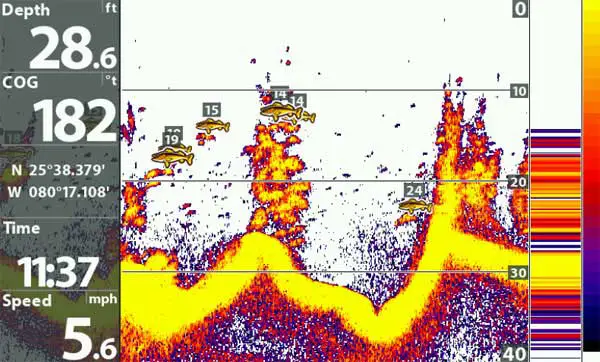
SwitchFire Sonar
The included switchfire sonar is a sweet addition to this device to help you customize how you want to get returns on your screen.With a single push of the button, you can use the two display modes to watch and lure presentations, remove or add detail, account for water temperature, depth, and turbulence.
Humminbird Basemap Built-in
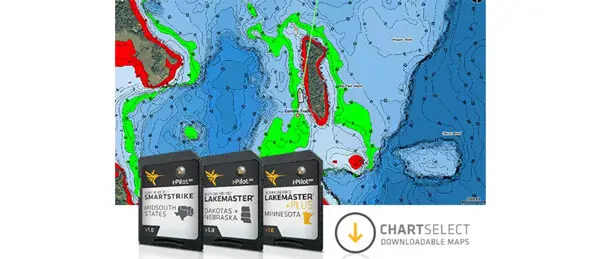
Another nice feature that is worthy of mention is the Basemap Built-in feature. The Simple function of this Basemap is to deliver an unprecedented clear view of surrounding points of interest, and a clear picture of underwater terrain to let you navigate with the right information.
Of course, the Basemap will show you where day markers are located. You will be able to spot, hazardous terrain, identify buoys, and make a judgment of depth markers, contours, and marinas.
Ethernet Networking and Bluetooth Networking
With a High-speed Ethernet, you can build a powerful fishing system by connecting several fish finders with this unit. Did I also mention that this unit is compatible with many maps? You can quickly work on maps such as Navionics Platinum, and Navionics.The best part is that you can even connect the unit with your phone--thanks to its Bluetooth networking system that lets you receive notifications on your phone while in your pockets.
Does it have an SD card?
As a Mega image unit, it does have a 32 gig SD card. While that is true, you DON'T have to buy a transducer for this unit.Drawbacks
We noticed you couldn't multitask with this unit. You are limited to the number of tasks you can carry out at a time. Also, the 360 screen takes time to start pinging. So you have to wait a couple of minutes before it picks up.
PROS
- Outstanding MEGA Side Imaging and regular Side Imaging
- MEGA Down Imaging and regular Down Imaging
- Included CHIRP DualBeam Plus Sonar
- Screen Snapshot functions and Sonar Recording
- Gorgeously Built-in Basemaps
- Compatible with Navionics, LakeMaster Plus, Gold/HotMaps, Navionics and SmartStrike charts and Platinum+
- IPX7 waterproof
CONS
- No enough computing power for multitasking
- Takes time to use the 360 screen
2. Garmin Echomap Plus 73SV with CV52HW-TM Transducer, 010-01897-01

The 7 inch Garmin Echomap Plus fish finder is a brilliant device that can be read even under sunlight. It offers the precious combination and convenience of keys and touch screen.
Design

The unit comes with a single transducer encompassing Garmin CHIRP regular sonar plus CHIRP ClearVu and CHIRP SideVu scanning sonars.
The Echomap fish finder is compatible with Panoptix all-seeing sonar. With an inbuilt Wi-Fi, you can pair with the ActiveCaptain app for free. This is useful when accessing OneChart where you can buy and download new charts.
CHIRP Sonar and Transducer
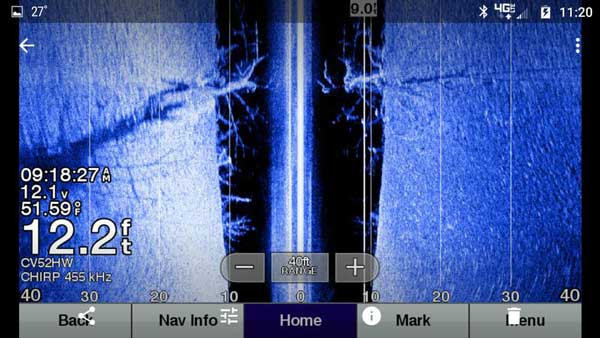
The Echomap is capable of several functions thanks to the inbuilt sonar capacities. The CHIRP sonar gives incredibly clear visuals. It also provides support for MotorGuide and Minn Kota with integrated transducers.
The Garmin Echomap ClearVu scanning solar provides an image that looks almost like the exact photographic image of what is in the underwater.
The SideVu, on the other hand, provides incredible detail of what life on the sides of the boat.
GPS & Navigation
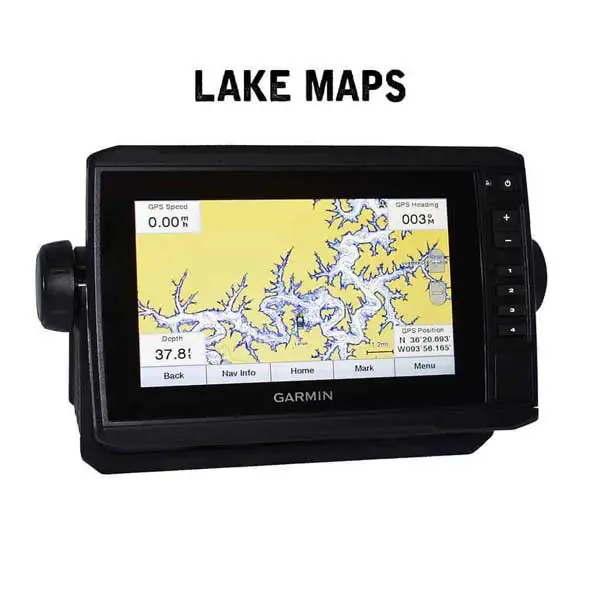
The Garmin fish finder comes preloaded with LakeVu HD Maps which are highly detailed freshwater maps of more than 17,000 U.S. rivers, lakes, and reservoirs. The LakeVu HD provides users with amazing detail of underwater features.
Additionally, Shallow Water Shading allows you to decide on a minimum depth. It gives you details of wide roads, interstates, bridges, boat ramps, designated fishing locations, and campgrounds.
PROS
- Bright, sunlight-readable 7” keyed-assist touchscreen combo
- Includes transducer for Garmin high, full CHIRP traditional sonar plus CHIRP ClearVü™ and CHIRP SideVü™
- Sonars compatible with Panoptix™ all-seeing sonar
- Preloaded LakeVü HD maps include 17,000+ lakes, reservoirs, and rivers
- 13,000 locations with 1’ contours
- Built-in Quickdraw Contours mapping software creates fishing maps with 1’ contours as
- Free access to OneChart™, smart notifications¹, Garmin Quickdraw™ Community data
- Use built-in Wi-Fi® to pair with the free ActiveCaptain™ app
CONS
- Doesn’t include NMEA 2000 adapter Cable
3. Garmin Striker Plus 9SV with CV52HW-TM Transducer, 010-01875-00

The new Garmin Striker Plus 9SV fish finder comes as a 9-inch unit which is an upgrade on the older 7-inch versions. It has fundamental navigation features, a GPS plotter, as well as the Quickdraw Contours feature.
Design

As a 9-inch display unit, the Garmin Striker display is a full-color WVGA-esque device. It has an 800 x 480 resolution incorporated with LED backlight which helps to improve the device’s readability under sunlight.
The Striker 9SV is IPX7 waterproof, meaning it can withstand water exposure and even rain. Additionally, the unit comes with a built-in Wi-Fi. This feature enables the user to connect to the ActiveCaptain app.
CHIRP Sonar and Transducer

The Garmin Striker unit comes with the CV52HW-TM transducer. The transducer includes a temperature sensor; it has about 20 ft cable and a 12-pin connector.
The transducer supports various frequency ranges including 50/77/200 kHz. However, it doesn’t support Panoptix transducers.
The transducer’s coverage is between 24 degrees and 16 degrees for the 2D CHIRP sonar. The sonar has a depth capacity of about 800 ft. The transducer makes use of thin beams for SideVu and ClearVu.

GPS & Navigation
While the Garmin Striker may not be a full-fledged chartplotter like the Garmin Echomap, this fish finder still offers the fundamental and most important sets of navigation features. With the basic GPS potter’s capability of showing the precise location of the boat, the navigation features on this fish finder can help you get the job done.
PROS
- 9-inch display suitable for Side Imaging
- Traditional CHIRP
- SideVU and ClearVU CHIRP
- Dual-beam
- Water temperature sensor
- Adjustable depth line (measures the depth of underwater objects)
- AutoGain Technology
- Fish Symbol ID (helps identify fish targets)
- Split-screen zoom
- Wireless Connectivity
- Quickdraw Contours
- Integrated GPS
- Mark Waypoints
- Course over Ground (COG)
- Ultrascroll® (displays fish targets at higher boat speeds)
CONS
- No microSD card
- No unit cover
4. Lowrance Hook2 9- 9-inch Fish Finder with TripleShot Transducer and US Inland Lake Maps Installed

The Lowrance Hook2 9 inch fish finder has been described as the easiest fish finder in the universe by its manufacturer. With the Lowrance Hook2, users will spend less time with the device settings and more time fishing.
Design

Coming in a 9-inch display, this device is the perfect blend of power and simplicity. It comes with menus that are quite easy to understand as well as broad angle CHIRP sonar coverage.
With its direct access keypad and intuitive interface, this is a fish finder that actually helps you focus on the job.
CHIRP Sonar and Transducer

The TripleShot transducer gives you conventional high CHIRP full angle sonar including DownScan imaging and SideScan imaging. With TripleShot, you can track baits, identify structures beneath the boat, mark fish, and scan areas around you.
The Autotuning sonar technology also adjusts the sonar settings as the water conditions change. This is to ensure that you have the best image any time.
GPS & Navigation
If you are like the average user who only needs the basic navigation, the simple yet accurate GPS plotter found on the Hook2 is a perfect fit as you can add waypoints, navigate to your fishing location, and follow trails.
PROS
- Available in five screen sizes -- 4”, 5”, 7”, 9” and 12.”
- High-resolution, SolarMAX display
- Autotuning sonar
- Double the CHIRP sonar coverage of most fishfinders
- Broadband Sounder, High CHIRP, SideScan, and DownScan Imaging™ sonar options
- Full Chartplotter and basic GPS navigation options
- Preloaded C-MAP US Inland Mapping and C-MAP® US Coastal mapping
- Three transducer options available – TripleShot 3-in-1 sonar, SplitShot 2-in-1 sonar, and Bullet
- 2D High, wide CHIRP Sonar
- MicroSD reader
- Sonar recording
- Compatible with superior charts, including Navionics
CONS
- Not networkable
- No NMEA or Ethernet ports
- No support for GPS or AIS
How To Choose The Best Side Imaging Fish Finder?
Choosing the best side scan fish finder comes with the benefit of viewing underwear structure and catching more fish. But with so many options on the market, selecting the perfect side imaging fish finder can be intimidating!We have outlined some of the tips to guide you through the process of selecting a side imaging fishfinder to give you the most experience. This guide will make it easier, by exposing the tips and tricks of choosing the best side imaging fish finder for you.
Frequencies
Pay attention to the frequency ranges to help you know how powerful the sonar scanner is. If you are going to be fishing more on deeper water, then lower frequency might be what you want to go for.On the contrary, side sonars with higher rates will make a lot of sense in shallow water.
Power
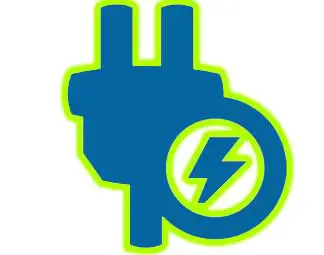
This is straightforward and simple. Ensure you go for a device that has a higher power. The reason is that the stronger the power, the higher the watts.
Screen Resolution
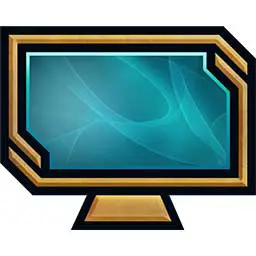
The screen resolution of a side scan imaging fishfinder is a critical factor you want to consider when picking a side imaging fish finder. A good screen resolution will enable you to see precise details of the world below you and let you locate fish on time.
Screen Color
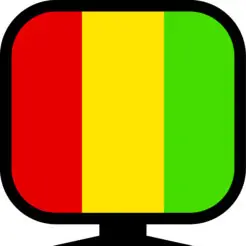
Aside from screen resolution, you also want to consider the screen color when choosing a side imaging fishfinder. You want to make sure the device features a color screen, as this has been proven to offer more peripheral and in-focus detail.
This will also help you differentiate the information on the screen and provide you with a clear detail of underwater structure.
Consider the Trolling Motor
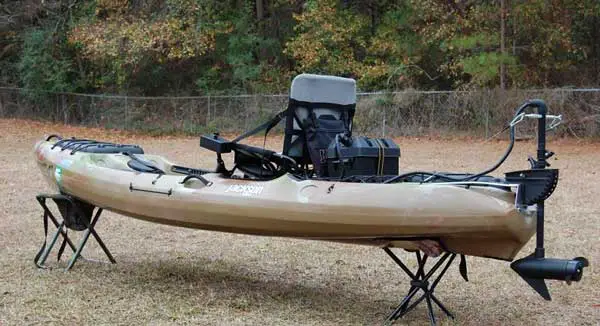
Another tip for choosing the best fish finder is the trolling motor that is on the front of your boat. You need a GPS that works with your trolling motor; otherwise, you may have to re-outfit the entire boat.
How big and how much unit do you actually need
If you're make a living catching fish, or on guided trips or a fishing tournament, you need a speedy processor, with the best picture output on your screen.Transducer
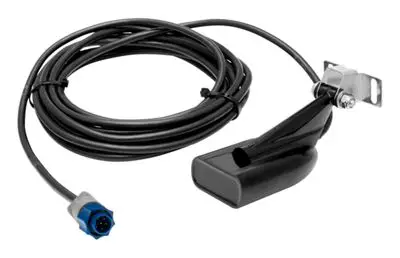
You want to find out if the device comes with a transducer or not. An included transducer in a side imaging fishfinder will come in handy in locating fish underneath your boat.
If the fishfinder you want to buy doesn't offer a transducer, then it will make a lot of sense to go with a fishfinder that comes with a transducer.
So, keep these little bits of info in mind when you want to shop for the best fish finders that are available online.
FAQs:
1. How to Read Side Imaging Fish Finder?
To accurately read side imaging fish finder, you need to know the three most important aspects of understanding a fish finder.- One, ensure you match the speed chart to your boat speed.
- Two, set the scan range in a small area to get more details.
- Three, avoid turning by scanning in a slow straight line.
2. Does Side Imaging Work on a Kayak?
Yes, side imaging works on a kayak. Kayak fishing may be a disadvantage as it doesn’t cover much water the way a normal bass boat would. However, side imaging makes it easy to view more water body that could have taken hours to see with down imaging or regular sonar. It helps you to find underwater features quite easily.3. How to Mount Side Imaging Transducer on Kayak?
Basically, the side imaging transducer has to be mounted externally. You can mount it on a motor using the transducer brackets. It should be mounted on the side of the boat without any obstructions blocking the visuals of the side imaging transducer.You should also avoid any form of cavitation which can hamper the quality of the images.
Our Verdict
Having reviewed our best side imaging fish finders 2018, we can clearly state that the Humminbird Helix 10 is the clear winner. The fish finder packs several incredible features; the intuitive interface, the option for an SD card, the positioning, and a host of other features make it our top recommended side imaging unit.If you have any question or think we have left out your favorite side scan fish finder in this side imaging fish finder comparison guide, let us know in the comments.
https://fishfinderbrand.com/best-side-imaging-scan-fish-finder/









